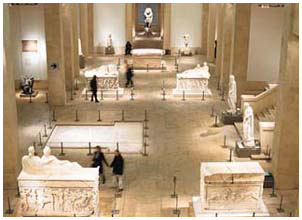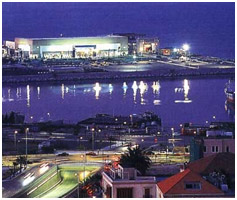

: GUIDE INFO :
- About Us
- Contact Us
- Social Media
- F.A.Q
- Plans
- Albums
- News & Events
- Get A Website
- Marketing Tips
- Useful Links
- International Links
: HOTELS DIRECTORY :
- Beirut Hotels
- Bekaa Hotels
- Mount Lebanon Hotels
- North Lebanon Hotels
- South Lebanon Hotels
: LEBANON INFO :
- Transportation In Lebanon
- Touristic Sites
- Featured Resorts
- Resorts>
- Grottos
- Embassies in Lebanon
- Photo Gallery
- Articles About Lebanon
- Songs About Lebanon
: SISTER SITES :
- AtLebanon Directory
- Advertise Lebanon
- Professional Innovations
- Lebanon Auto Guide
- Bcharre Chalet & Motel
: GOOGLE ADS :
|
» BEIRUT CITY LEBANON
 Approaching Beirut either by sea or air promises an unforgettable sight. The mountains rising behind the city are bathed in sunlight 300 days of the year and in winter, when they glisten under a blanket of snow. The destroyed town center is once again active. Its former reputation as a crossroads between three continents and gateway to the East has been restored and modernized. The new city planners hold computer-rendered plans that show an extended coastline, a new residential area, and a touristic recreational zones built around a central park.
Approaching Beirut either by sea or air promises an unforgettable sight. The mountains rising behind the city are bathed in sunlight 300 days of the year and in winter, when they glisten under a blanket of snow. The destroyed town center is once again active. Its former reputation as a crossroads between three continents and gateway to the East has been restored and modernized. The new city planners hold computer-rendered plans that show an extended coastline, a new residential area, and a touristic recreational zones built around a central park.
Beirut's history dates back over 5,000 years. Under the city's downtown area lie remnants of Ottoman, Mamluke, Crusader, Abbassid, Omayyad, Byzantine, Roman, Persian, Phoenician and Canaanite Beirut.Its name first appeared in cuneiform as early as the 14th century B.C. In the first century B.C., it became a Roman colony, only to be destroyed later by a triple catastrophe of earthquake, tidal wave and fire in 551A.D. Arab control then dominated until the Crusaders took over in 1110. Following the Crusaders were the Mamlukes and the Turks. After World War I there was a French mandate period, and in 1943 Lebanon gained its independence.Beirut stands on the site of a very ancient settlement going back at least 5,000 years. Its name appeared in cuneiform inscriptions as early as the 14th century B.C. In the first century B.C., Berytus, as it was then called, became a Roman Colony and under Roman rule was the seat of a famous Law school which continued into the Byzantine era. But the power and the glory of Berytus were destroyed by a triple catastrophe of earthquake, tidal wave and fire in 551 A.D. In the following century Arab Muslim forces took the city and in 1110 it fell into the Crusaders. Beirut remained in Crusader hands until 1291 when it was conquered by the Mamlukes. Ottoman rule began in 1516, continuing for 400 years later until the defeat of the Turks in World War I. The French Mandate Period followed and in 1943 Lebanon gained its independence.
All discoveries are being carefully recorded and many will be preserved. Opened in 1942 to house Lebanon's archeological treasures, the National Museum on Damascus Street. A tour of the old downtown should include the Omari Mosque, the Municipality Building, the Assaf and Amir Munzir Mosques, the Arcaded Maarad Street, the Parliament Building, the Roman columns on Nejmeh Square and the historic Greek Orthodox and Greek Catholic churches opposite the Parliament.The best way to see Beirut is on foot. A good place to rest is the area of Raouche, where Beirut's famous Pigeon Rocks stand tall and proud in the sparkling sea. Area restaurants serve local and foreign cuisine and cliff-side cafes offer a good range of snacks. |
|






 A city continuously inhabited for millennia, until recently most of the few archaeological discoveries in Beirut were accidental. However the war's end in 1991 provided opportunity for more comprehensive and scientific investigation. Beneath the ruined downtown area, which is under reconstruction, lie the remains of Ottoman, Mamluke, Crusader, Abbassid, Omayyad, Byzantine, Roman, Persian, Phoenician and Canaanite Beirut. With luck, a good portion of Beirut's history will be uncovered before reconstruction is complete.
A city continuously inhabited for millennia, until recently most of the few archaeological discoveries in Beirut were accidental. However the war's end in 1991 provided opportunity for more comprehensive and scientific investigation. Beneath the ruined downtown area, which is under reconstruction, lie the remains of Ottoman, Mamluke, Crusader, Abbassid, Omayyad, Byzantine, Roman, Persian, Phoenician and Canaanite Beirut. With luck, a good portion of Beirut's history will be uncovered before reconstruction is complete. 



 Lebanon Auto Guide
Post,Buy your car.
Lebanon Auto Guide
Post,Buy your car.
 Chalets & Loding Rooms
One of Besharry/Al-Arz Tourists Destination
Chalets & Loding Rooms
One of Besharry/Al-Arz Tourists Destination